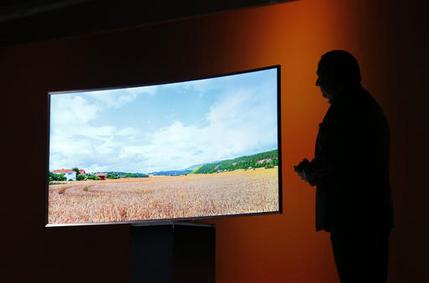- California Assembly OKs highest minimum wage in nation
- S. Korea unveils first graphic cigarette warnings
- US joins with South Korea, Japan in bid to deter North Korea
- LPGA golfer Chun In-gee finally back in action
- S. Korea won’t be top seed in final World Cup qualification round
- US men’s soccer misses 2nd straight Olympics
- US back on track in qualifying with 4-0 win over Guatemala
- High-intensity workout injuries spawn cottage industry
- CDC expands range of Zika mosquitoes into parts of Northeast
- Who knew? ‘The Walking Dead’ is helping families connect
YOUR TV MAY USE MORE ENERGY THAN YOU THINK, GROUP CHARGES
SAN FRANCISCO (AP) — An environmental group on Wednesday accused three major television manufacturers of misleading consumers and regulators about how much energy their high-definition screens devour by designing them to draw less power during government testing than in ordinary use. 
The report by the Natural Resources Defense Council concluded that the TVs made by Samsung, LG Electronics and Vizio saddle households with an extra $120 million in electricity bills each year and generate tons of additional pollution.
The added expense works out to about $10 to $20 per household annually over the anticipated decade-long life of the typical widescreen TV.
Both Samsung and LG Electronics disputed the findings.
“It appears that some major manufacturers have modified their TV designs to get strong energy-use marks during government testing but may not perform as well in consumer homes,” said Noah Horowitz, senior scientist and director for the NRDC’s center for energy efficiency standards.
The findings are based on an analysis of high-definition TVs with screens spanning at least 55 inches made in 2015 and 2016. The estimates on electricity costs are based on high-definition TVs with screens 32 inches and larger.
The study concluded that Samsung and LG exploited the testing system to get better scores on the yellow “EnergyGuide” labels that appear on sets in stores. Those scores often influence the buying decisions of consumers looking to save money on utility bills.
The report said Samsung and LG did not break any laws but rather exploited weaknesses in the Department of Energy’s system to measure electricity usage. The behavior “smacks of bad faith,” Horowitz said.
Samsung and LG sets have a dimming feature that turns off the screens’ backlight during the 10-minute video clip used in government tests, according to the study. But that does not typically happen when the sets are being used in homes to watch sports, comedies, dramas and news programming.
The reason the TVs perform differently during the tests is because the government relies on an 8-year-old clip that stitches together 260 separate scenes that rapidly change, keeping the backlight off. The NRDC study found scenes lasted longer in a football game, the HBO comedy “Silicon Valley,” the AMC drama “Breaking Bad” and a CNN program. The longer scenes resulted in the picture staying brighter, drawing more electricity than in government tests.
LG spokesman John Taylor wrote in an email that the company was “confident that our products are being tested properly and are delivering energy efficiency in real world use.”
Samsung said the government-tested ratings are based on the factory settings for the picture – something that most consumers do not change.
Vizio did not respond to requests for comment.
The NRDC called on the Department of Energy to test energy usage with a montage of clips mirroring how TV is typically watched in homes. The department said Wednesday that it is reviewing whether it needs to change its testing to keep up with the latest TV technology.
The analysis also found that Samsung, LG and Vizio disable energy-saving features in their TVs when consumers change the factory setting on the picture with a remote control. The report estimated that happens in one-third of all homes.
The energy-saving feature is turned off with little or no warning on the screen, sometimes doubling the amount of electricity consumed, according to the NRDC report. This potential uptick in energy usage is not detected in government testing either.
Other TV sets made by Sony and Philips did not deactivate their power-saving features when changes were made to the default setting for the picture, according to the study.
Add it all up, and the report estimates that total electricity bills during a decade of watching the high-definition TVs will be $1.2 billion higher than the energy ratings imply. The higher energy usage generates an additional 5 million metric tons of carbon pollution, potentially affecting the climate, the report warned.













how to start
September 21, 2016 at 8:57 PM
Light Reading
flattery will get
September 21, 2016 at 11:02 PM
Social Media & Outreach | National Institutes of Health …
movement
September 21, 2016 at 11:57 PM
Today’s Stock Market News and Analysis – Nasdaq.com
how to get
September 22, 2016 at 12:47 AM
The orb – high noon – YouTube
hair dos
September 22, 2016 at 1:27 AM
The New York Times – Breaking News, World News & …
how to get
September 22, 2016 at 1:37 AM
EE Times | Electronic Engineering Times | Connecting the …
black dos hair
September 22, 2016 at 10:09 PM
Dillard’s – Official Site of Dillard’s Department Stores …
prom style
September 23, 2016 at 8:21 AM
Political Commentary and Opinion | Washington Examiner